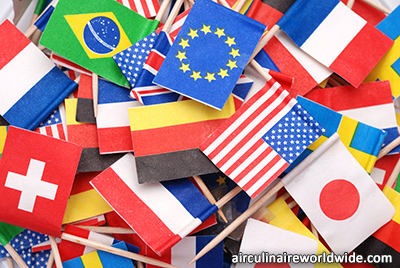While traveling the globe in a private jet, you will notice that in-flight catering processes vary from place to place. Differences can be found in everything from pricing, to packaging and portion size, to airport infrastructure. Prices may be higher, and orders and revisions may need more lead time outside the United States. Factoring in plenty of additional lead time for coordinating your in-flight catering will yield the most successful results.
Whether in-flight catering orders are placed through a flight department or crew, it is best to designate a single point of contact for all catering communications. Whoever is responsible for placing catering orders should have a thorough understanding of in-flight catering and food safety. Considerations include the delivery process, onboard storage, how the food will be served, and galley equipment limitations. No matter who is responsible for placing the orders, communication is critical, and everyone should be kept informed of any updates.
When flying to a location for the first time, make sure to call the local in-flight caterer or 3rd-party provider well in advance. This will allow you to learn about their requirements concerning overall capabilities, lead time, revisions, cancellations, and payment policy. It is best to collect as much information ahead of time as possible. In certain locations, caterers may operate on a cash-only basis or require direct payment from an approved handler or 3rd-party provider. For the smoothest experience, it is recommended to arrange catering payment via credit through a 3rd-party provider, as it will eliminate the need to take extra time to pay for the catering upon delivery when you are in a time crunch.
Occasionally, it is better to double-provision at a previous stop. If the catering is packaged and stored correctly, it will usually clear customs with no problems. However, is it always important to find out which food items are prohibited before planning to take them to your next stop. Food export regulations, especially when concerning produce, vary, depending on the country.
Catering is typically stored in Fixed-Base Operators (FBOs) or similar buildings while traveling in North America. However, this is usually not the case in other regions. Instead, catering is delivered directly to the aircraft, typically without any storage or refrigeration locations at the airport. This makes coordination, communication, and planning absolute musts.
When planning your catering, also take time to research each location you will be visiting and note any location events and holidays that will be occurring during your travel period. Depending on the country, holidays and customs can severely impact availability. Many countries celebrate holidays that are taken very seriously. During these national holidays, everything shuts down, and you will be left without access to caterers, grocery stores, or restaurants unless you plan ahead. Local holidays also are important to know about in advance since they may cause all businesses in one area to close while everything in the next location remains open.
Aside from holidays, which shut down entire towns, strikes can also affect your trip. When the group organizing a strike announces their intention to do so, this allows time to prepare and avoid any issues. However, some strikes may occur without notice, and your operation, including your in-flight catering, will be affected. For this reason, it is always suggested to keep some snacks in stock or develop an alternate plan in order to lessen the impact of unexpected events.
In-flight catering prices can vary depending on the location, and some destinations are known for being significantly more expensive than the average. Delivery fees may also drive up costs because, in many places, catering is delivered directly to the aircraft. The big exception is the United States, where the delivery fee for delivering aviation catering to an FBO is usually minimal. At some international locations, fees and taxes, not the catering itself, may actually be the majority of your cost. If you are flying to somewhere new, and you are used to the pricing at your home base, plan ahead so you aren’t taken by surprise.
International catering often comes with the need to strike a balance between being specific and being flexible. It is important to communicate clearly in order to convey specific information about food allergies or preferences. However, if you have room for flexibility, allow your local aviation caterer to make recommendations based on the meal period and client preferences. Your in-flight catering experience will be more rewarding with a mix of planning ahead, flexibility in cuisine, local ingredients, and the chef’s suggestions.
Questions?
If you have any questions about international in-flight catering, contact weborders@airculinaire.com.






